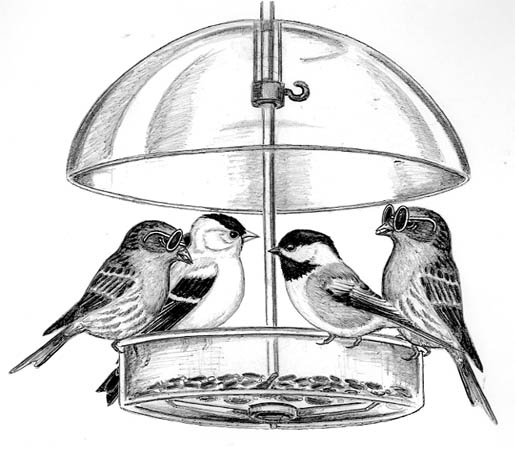
Dear Bird Folks,
Last week I had an odd-looking House Finch at my feeder. One of its eyes was nearly swollen shut. Then, a few days later, I saw a goldfinch with the same problem. What is wrong with these birds? Is there something I can do to help them?
– Mary, Brewster, MA
It’s gross, Mary,
The birds that you described have a type of avian conjunctivitis. It causes the bird’s eye, or eyes, to become red, swollen and sometimes totally closed. It’s a disfiguring illness and as the disease advances the stricken birds become pretty creepy looking. Anyone who hasn’t seen birds in this condition should take my word for how nasty it is and not go running to the Internet to look for pictures. Finches with avian conjunctivitis aren’t for the squeamish. These poor birds look like boxers after a fight, or like hockey players after a game or like Bernie Madoff will if any of his old customers get a hold of him. Yes, it’s that bad.
Feeder birds, like all other creatures, have their share of illnesses they have to deal with. For the most part the birds survive these illnesses, but even if they don’t survive, the end result has little effect on their overall population. This is not the case for House Finches and their battle with avian conjunctivitis, or Mycoplasmal conjunctivitis, as it likes to be called. This illness has had a severe impact on House Finches, drastically reducing their numbers over the past decade.
The House Finch, a bird that some people still stubbornly call “Purple Finch,” is an extremely common bird at feeders. (Cape Cod does have a few of the similar-looking Purple Finches, but they are rare and these people need to get new bird books.) The House Finch is also an abundant local breeder, and it loves to build its nests in our hanging plants or on our porch lights. As many of you already know, this is a new bird in the East; it’s a forced transplant from the West Coast. In a very short period of time, a handful of introduced finches grew to millions. The House Finch population became so large that it began driving goldfinches away from thistle feeders, causing manufacturers to begin producing House Finch-proof feeders. Then an odd thing happened. Just as these new feeders were hitting the store shelves, the House Finch population began to drop fast, really fast. Maybe not as fast as my retirement fund has dropped recently, but still pretty fast.
Why did the population drop? The massive population of Eastern House Finches all derived from those few transplanted Western birds. Eastern birds are basically all inbred and thus genetically inferior. (In spite of what some people may think, a diverse population is typically a healthier population. Wrong again, Adolph.) In 1994 a few House Finches near Washington, DC were discovered with swollen eyes, just like your birds, Mary. As the disease quickly spread through the flocks of House Finches, their population plummeted and suddenly no one needed a House Finch-proof feeder anymore. While avian conjunctivitis does occasionally infect other feeder birds, like your goldfinch, for example, it has had little impact on the population of those other birds, which is lucky for me and my birdseed sales.
What to do if you see a sick bird: Anyone who has a finch with a nasty-looking eye should take their feeders inside and thoroughly clean them with a 10% bleach solution. (Don’t freak out, this a bird disease. Humans and furry pets can’t catch it.) If you have a birdbath in the yard, you should remove that, too. Rake up under your feeders and don’t offer the birds any food for a week or two. Doing this will force the healthy birds to leave the area and will give the sick bird an opportunity to become a full-fledged member of the food chain. The conjunctivitis doesn’t necessarily kill the birds, but it does impair their vision, which makes them easy prey for predators. I know removing a sick bird’s only food source seems kind of cold, but this disease is contagious and the sooner the afflicted birds are out of the picture, the safer things will be for the healthy birds.
Right now many of you bleeding hearts are wondering: Why not treat the sick bird instead of letting it die or become hawk food? Being a bleeding heart myself I asked the same question. At first avian conjunctivitis had a huge impact on the House Finch population, but now things have leveled off and only a small percentage of these birds are having difficulties. Researchers are concerned that if the sick birds were treated, the disease would morph into some kind of super-conjunctivitis that would be far more deadly than the form the birds are dealing with now. (Note: To get the full effect of that last sentence reread it with the theme song from Dragnet playing in your head. Try it. You’ll see.)
By the time this column hits the papers, Mary, your sick finches will have probably moved on to the big thistle feeder in the sky. But if you are still seeing them, you know what you have to do. I know it seems harsh, but those sick birds need to come out of the gene pool. Too bad the same thing didn’t happen to Bernie Madoff.